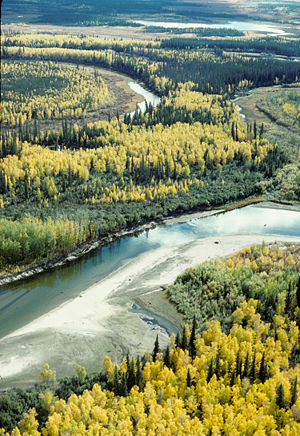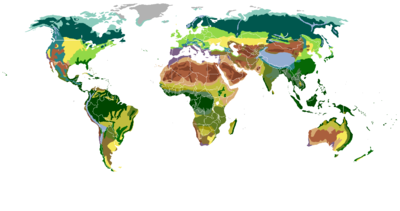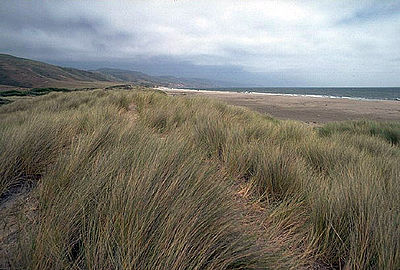
Vegetation
Background to the schools Wikipedia
SOS Children, which runs nearly 200 sos schools in the developing world, organised this selection. SOS Child sponsorship is cool!
Vegetation is a general term for the plant life of a region; it refers to the ground cover provided by plants. It is a general term, without specific reference to particular taxa, life forms, structure, spatial extent, or any other specific botanical or geographic characteristics. It is broader than the term flora which refers exclusively to species composition. Perhaps the closest synonym is plant community, but vegetation can, and often does, refer to a wider range of spatial scales than that term does, including scales as large as the global. Primeval redwood forests, coastal mangrove stands, sphagnum bogs, desert soil crusts, roadside weed patches, wheat fields, cultivated gardens and lawns; all are encompassed by the term vegetation.
Importance
Vegetation supports critical functions in the biosphere, at all possible spatial scales. First, vegetation regulates the flow of numerous biogeochemical cycles (see biogeochemistry), most critically those of water, carbon, and nitrogen; it is also of great importance in local and global energy balances. Such cycles are important not only for global patterns of vegetation but also for those of climate. Second, vegetation strongly affects soil characteristics, including soil volume, chemistry and texture, which feed back to affect various vegetational characteristics, including productivity and structure. Third, vegetation serves as wildlife habitat and the energy source for the vast array of animal species on the planet (and, ultimately, to those that feed on these). Vegetation is also critically important to the world economy, particularly in the use of fossil fuels as an energy source, but also in the global production of food, wood, fuel and other materials. Perhaps most importantly, and often overlooked, global vegetation (including algal communities) has been the primary source of oxygen in the atmosphere, enabling the aerobic metabolism systems to evolve and persist. Lastly, vegetation is psychologically important to humans, who evolved in direct contact with, and dependence on, vegetation, for food, shelter, and medicine.
Classification
Much of the work on vegetation classification comes from European and North American ecologists, and they have fundamentally different approaches. In North America, vegetation types are based on a combination of the following criteria: climate pattern, plant habit, phenology and/or growth form, and dominant species. In the current US standard (adopted by the Federal Geographic Data Committee (FGDC), and originally developed by UNESCO and The Nature Conservancy), the classification is hierarchical and incorporates the non-floristic criteria into the upper (most general) five levels and limited floristic criteria only into the lower (most specific) two levels. In Europe, classification often relies much more heavily, sometimes entirely, on floristic (species) composition alone, without explicit reference to climate, phenology or growth forms. It often emphasizes indicator or diagnostic species which separate one type from another.
In the FGDC standard, the hierarchy levels, from most general to most specific, are: system, class, subclass, group, formation, alliance, and association. The lowest level, or association, is thus the most precisely defined, and incorporates the names of the dominant one to three (usually two) species of the type. An example of a vegetation type defined at the level of class might be "Forest, canopy cover > 60%"; at the level of a formation as "Winter-rain, broad-leaved, evergreen, sclerophyllous, closed-canopy forest"; at the level of alliance as "Arbutus menziesii forest"; and at the level of association as "Arbutus menziesii-Lithocarpus densiflora forest", referring to Pacific madrone-tanoak forests which occur in California and Oregon, USA. In practice, the levels of the alliance and/or association are the most often used, particularly in vegetation mapping, just as the Latin binomial is most often used in discussing particular species in taxonomy and in general communication.
Structure
A primary characteristic of vegetation is its three-dimensional structure, sometimes referred to as its physiognomy, or architecture. Most people have an understanding of this idea through their familiarity with terms like "jungle", "woods", "prairie" or "meadow"; these terms conjure up a mental image of what such vegetation looks like. So, meadows are grassy and open, tropical rainforests are dense, tall and dark, savannas have trees dotting a grass-covered landscape, etc.
Obviously, a forest has a very different structure than a desert or a backyard lawn. Vegetation ecologists discriminate structure at much more detailed levels than this, but the principle is the same. Thus, different types of forests can have very different structures; tropical rainforests are very different from boreal conifer forests, both of which differ from temperate deciduous forests. Native grasslands in South Dakota, Arizona, and Indiana are visibly different from each other, low elevation chaparral differs from that at high elevations, etc.
Structure is determined by an interacting combination of environmental and historical factors, and species composition. It is characterized primarily by the horizontal and vertical distributions of plant biomass, particularly foliage biomass. Horizontal distributions refer to the pattern of spacing of plant stems on the ground. Plants can be very uniformly spaced, as in a tree plantation, or very non-uniformly spaced, as in many forests in rocky, mountainous terrain, where areas of high and low tree density alternate depending on the spatial pattern of soil and climatic variables. Three broad categories of spacing are recognized: uniform, random and clumped. These correspond directly to the expected variation in the distance between randomly chosen locations and the closest plant to such locations. Vertical distributions of biomass are determined by the inherent productivity of an area, the height potential of the dominant species, and the presence/absence of shade tolerant species in the flora. Communities with high productivities and in which at least one shade tolerant tree species is present, have high levels of biomass because of their high foliage densities throughout a large vertical distance.
Although this discussion centers on biomass, it is difficult to measure in practice. Ecologists thus often measure a surrogate, plant cover, which is defined as the percentage of the ground surface area that has plant biomass (especially foliage) vertically above it. If the vertical distribution of the foliage is broken into defined height layers, cover can be estimated for each layer, and the total cover value can therefore be over 100; otherwise the values range from zero to 100. The measure is designed to be a rough, but useful, approximation of biomass.
In some vegetation types, the underground distribution of biomass can also discriminate different types. Thus a sod-forming grassland has a more continuous and connected root system, while a bunchgrass community's is much less so, with more open spaces between plants (though often not as drastic as the openings or spacings in the above-ground part of the community, since root systems are generally less constrained in their horizontal growth patterns than are shoots). However, below-ground architecture is so much more time-consuming to measure, that vegetation structure is almost always described in relationship to the above-ground parts of the community.
Dynamics
Like all biological systems, plant communities are temporally and spatially dynamic; they change at all possible scales. Dynamism in vegetation is defined primarily as changes in species composition and/or vegetation structure.
Temporal dynamics
Temporally, a large number of processes or events can cause change, but for sake of simplicity they can be categorized roughly as either abrupt or gradual. Abrupt changes are generally referred to as disturbances; these include things like wildfires, high winds, landslides, floods, avalanches and the like. Their causes are usually external ( exogenous) to the community--they are natural processes occurring (mostly) independently of the natural processes of the community (such as germination, growth, death, etc). Such events can change vegetation structure and species composition very quickly and for long time periods, and they can do so over large areas. Very few ecosystems are without some type of disturbance as a regular and recurring part of the long term system dynamic. Fire and wind disturbances are particularly common throughout many vegetation types worldwide. Fire is particularly potent because of its ability to destroy not only living plants, but also the seeds, spores, and living meristems representing the potential next generation, and because of fire's impact on faunal populations, soil characteristics and other ecosystem elements and processes (for further discussion of this topic see fire ecology).
Temporal change at a slower pace is ubiquitous; it comprises the field of ecological succession. Succession is the relatively gradual change in structure and taxonomic composition that arises as the vegetation itself modifies various environmental variables over time, including light, water and nutrient levels. These modifications change the suite of species most adapted to grow, survive and reproduce in an area, causing floristic changes. These floristic changes contribute to structural changes that are inherent in plant growth even in the absence of species changes (especially where plants have a large maximum size, i.e. trees), causing slow and broadly predictable changes in the vegetation. Succession can be interrupted at any time by disturbance, setting the system either back to a previous state, or off on another trajectory altogether. Because of this, successional processes may or may not lead to some static, final state. Moreover, accurately predicting the characteristics of such a state, even if it does arise, is not always possible. In short, vegetative communities are subject to many variables that together set limits on the predictability of future conditions.
Spatial dynamics
As a general rule, the larger an area under consideration, the more likely the vegetation will be heterogeneous across it. Two main factors are at work. First, the temporal dynamics of disturbance and succession are increasingly unlikely to be in synchrony across any area as the size of that area increases. That is, different areas will be at different developmental stages due to different local histories, particularly their times since last major disturbance. This fact interacts with inherent environmental variability (e.g. in soils, climate, topography, etc.), which is also a function of area. Environmental variability constrains the suite of species that can occupy a given area, and the two factors together interact to create a mosaic of vegetation conditions across the landscape. Only in agricultural or horticultural systems does vegetation ever approach perfect uniformity. In natural systems, there is always heterogeneity, although its scale and intensity will vary widely. A natural grassland may be relatively homogeneous when compared to the same area of partially burned forest, but highly diverse and heterogeneous when compared to the wheat field next to it.
Global vegetation patterns and determinants
At regional and global scales there is predictability of certain vegetation characteristics, especially physiognomic ones, which are related to the predictability in certain environmental characteristics. Much of the variation in these global patterns is directly explainable by corresponding patterns of temperature and precipitation (sometimes referred to as the energy and moisture balances). These two factors are highly interactive in their effect on plant growth, and their relationship to each other throughout the year is critical. Such relationships are shown graphically in climate diagrams. By graphing the long term monthly averages of the two variables against each other, an idea is given as to whether or not precipitation occurs during the warm season (when it is biologically most useful) and consequently the type of vegetation to be expected. For example, two locations may have the same average annual precipitation and temperature, but if the relative timing of the precipitation and seasonal warmth are very different, so will their vegetation structure and growth and development processes be.
Scientific study
Vegetation scientists study the causes of the patterns and processes observed in vegetation at various scales of space and time. Of particular interest and importance are questions of the relative roles of climate, soil, topography, and history on vegetation characteristics, including both species composition and structure. Such questions are often large scale, and so cannot easily be addressed by manipulative experimentation in a meaningful way. Observational studies supplemented by knowledge of botany, paleobotany, ecology, soil science etc, are thus very common in vegetation science.
History
Pre-1900
Vegetation science has its origins in the work of botanists and/or naturalists of the 18th century, or earlier in some cases. Many of these were world travelers on exploratory voyages in the Age of Exploration, and their work was a synthetic combination of botany and geography that today we would call plant biogeography (or phytogeography). Little was known about worldwide floristic or vegetation patterns at the time, and almost nothing about what determined them, so much of the work involved collecting, categorizing, and naming plant specimens. Little or no theoretical work occurred until the 19th century. The most productive of the early naturalists was Alexander von Humboldt, who collected 60,000 plant specimens on a five year voyage to South and Central America from 1799 to 1804. Humboldt was one of the first to document the correspondence between climate and vegetation patterns, in his massive, life-long work " Voyage to the Equinoctial Regions of the New Continent", which he wrote with Aimé Bonpland, the botanist who accompanied him. Humboldt also described vegetation in physiogonmic terms rather than just taxonomically. His work presaged intensive work on environment-vegetation relationships that continues to this day (Barbour et al, 1987).
The beginnings of vegetation study as we know it today began in Europe and Russia in the late 19th century, particularly under Jozef Paczoski, a Pole, and Leonty Ramensky, a Russian. Together they were much ahead of their time, introducing or elaborating on almost all topics germane to the field today, well before they were so in the west. These topics included plant community analysis, or phytosociology, gradient analysis, succession, and topics in plant ecophysiology and functional ecology. Due to language and/or political reasons, much of their work was unknown to much of the world, especially the English-speaking world, until well into the 20th century.
Post-1900
In the United States, Henry Cowles and Frederic Clements developed ideas of plant succession in the early 1900s. Clements is famous for his now discredited view of the plant community as a " superorganism". He argued that, just as all organ systems in an individual must work together for the body to function well, and which develop in concert with each other as the individual matures, so the individual species in a plant community also develop and cooperate in a very tightly coordinated and synergistic way, pushing the plant community towards a defined and predictable end state. Although Clements did a great deal of work on North American vegetation, his devotion to the superorganism theory has hurt his reputation, as much work since then by numerous researchers has shown the idea to lack empirical support.
In contrast to Clements, several ecologists have since demonstrated the validity of the individualistic hypothesis, which asserts that plant communities are simply the sum of a suite of species reacting individually to the environment, and co-occurring in time and space. Ramensky initiated this idea in Russia, and in 1926, Henry Gleason (Gleason, 1926) developed it in a paper in the United States. Gleason's ideas were categorically rejected for many years, so powerful was the influence of Clementsian ideas. However, in the 1950s and 60s, a series of well-designed studies by Robert Whittaker provided strong evidence for Gleason's arguments, and against those of Clements. Whittaker, one of the most productive of American plant ecologists, was a developer and proponent of gradient analysis, in which the abundances of individual species are measured against quantifiable environmental variables (or their well-correlated surrogates). In studies in three very different montane ecosystems, Whittaker demonstrated strongly that species respond primarily to the environment, and not necessarily in any coordination with other, co-occurring species. Other work, particularly in paleobotany, has lent support to this view at larger temporal and spatial scales.
Recent developments
Since the 1960s, much research into vegetation has revolved around topics in functional ecology. In a functional framework, taxonomic botany is relatively less important; investigations centre around morphological, anatomical and physiological classifications of species, having the aim of predicting how particular groups thereof will respond to various environmental variables. The underlying basis for this approach is the observation that, due to convergent evolution and (conversely) adaptive radiation, there is often not a strong relationship between phylogenetic relatedness and environmental adaptations, especially at higher levels of the phylogenetic taxonomy, and at large spatial scales. Functional classifications arguably began in the 1930s with Raunkiær's division of plants into groups based on the location of their apical meristems (buds) relative to the ground surface. This presaged later classifications such as MacArthur's r vs K selected species (applied to all organisms, not just plants), and the C-S-R scheme proposed by Grime (1974) in which species are assigned to one or more of three strategies, each favoured by a corresponding selection pressure: competitors, stress-tolerators and ruderals.
Functional classifications are crucial in modeling vegetation-environment interactions, which has been a leading topic in vegetation ecology for the last 30 or more years. Currently, there is a strong drive to model local, regional and global vegetation changes in response to global climate change, particularly changes in temperature, precipitation and disturbance regimes. Functional classifications such as the examples above, which attempt to categorise all plant species into a very small number of groups, are unlikely to be effective for the wide variety of different modeling purposes that exist or will exist. It is generally recognized that simple, all-purpose classifications will likely have to be replaced with more detailed and function-specific classifications for the modeling purpose at hand. This will require much better understanding of the physiology, anatomy, and developmental biology than currently exists, for a great number of species, even if only the dominant species in most vegetation types are considered.




